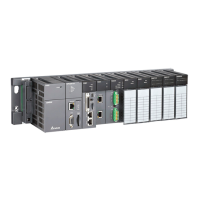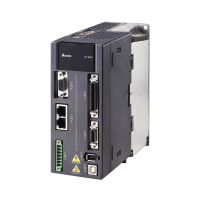Chapter 4 Instruction Structure
4-7
When M0 is ON, E0=10, and M1@E0=M (1+10)=M11. M11 is ON.
2. Declaring the variables first, and then modifying the device
Declare the three variables StartBit, Var1, and Var2 in ISPSoft.
The type of StartBit is the Boolean array, and its size is 2 bits. The range is from
StartBit[0] to StartBit[1].
The type of Var1 is the word array, and its size is 11 words. The range is from Var1[0] to
Var1[10].
The type of Var2 is the word, and its size is one word.
When StartBit[0] is ON, E0=10, E1=1, Var1[0]@E0=Var1[10], Var2=Var1[10], and
StrartBit[0]@E1=StartBit[1]. StartBit[1] is ON.
Additional remark: When users declare the variables in ISPSoft, and the variables are added
to the contents of the registers to form the addresses to the actual data,
users must note the addresses to prevent the program from being executed
wrongly.
4.4 Pointer Registers
ISPSoft supports the function blocks. When the variable declaration type is VAR_IN_OUT, and
the data type is POINTER, the variable is the pointer register. The value in the pointer register
can refer directly to the value stored in the device X, Y, D, or L, and the pointer register can
point to the address associated with the variable set automatically in ISPSoft.

